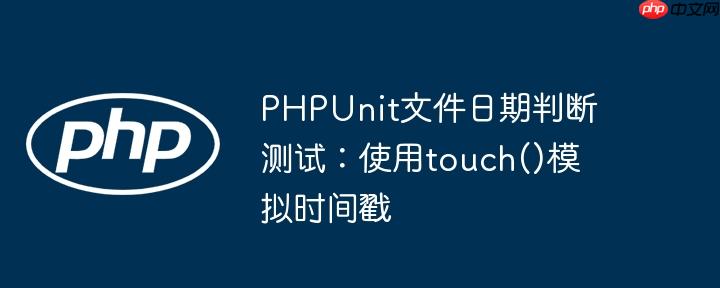
在开发过程中,我们经常会遇到需要判断文件“新鲜度”的业务场景,例如缓存文件是否过期、日志文件是否需要归档等。以下是一个常见的文件年龄检查方法:
class FileService
{
private function checkFileOutdated(string $filePath): bool
{
if (file_exists($filePath)) {
// 获取文件创建时间或inode修改时间
$fileTimeStamp = filectime($filePath);
$now = new DateTimeImmutable();
$fileDate = new DateTimeImmutable('@' . $fileTimeStamp);
$diff = (int) $now->format('Ymd') - (int) $fileDate->format('Ymd');
return $diff > 0;
}
return true; // 文件不存在,视为过时
}
}在为这类方法编写单元测试时,一个核心挑战是如何模拟一个“过时”的文件。直接在测试环境中等待文件自然变老显然不切实际。尝试使用系统命令 exec('touch -t ...') 来修改文件时间戳,虽然在终端显示成功,但在PHP代码中读取时却可能发现时间并未如预期般改变,这往往是由于对文件时间戳类型理解的偏差以及不同系统环境下命令行为的差异造成的。
在PHP中,有三个主要函数用于获取文件的时间戳:
在判断文件内容是否“过时”时,通常我们关心的是文件内容的最后一次修改时间,因此filemtime()是更准确、更常用的选择。原始代码中使用filectime()可能导致在某些系统或操作下出现不符合预期的行为。
为了在单元测试中可靠地模拟文件时间戳,我们应该使用PHP内置的touch()函数,而不是依赖外部的exec()调用。touch()函数允许我们创建文件(如果不存在)并设置其访问和修改时间。
立即学习“PHP免费学习笔记(深入)”;
bool touch ( string $filename [, int $time = time() [, int $atime = time() ]] )
示例:创建并设置一个过时文件
以下代码演示了如何创建一个临时文件,并将其修改时间设置为昨天:
<?php
// 1. 定义一个临时文件路径
$tempFilePath = sys_get_temp_dir() . '/test_outdated_file.txt';
// 2. 使用 touch() 函数设置文件的修改时间为昨天
// strtotime('-1 day') 会返回昨天的Unix时间戳
$yesterdayTimestamp = strtotime('-1 day');
touch($tempFilePath, $yesterdayTimestamp);
// 3. 验证文件时间戳
echo "文件修改时间 (filemtime): " . date('Y-m-d H:i:s', filemtime($tempFilePath)) . "\n";
echo "文件访问时间 (fileatime): " . date('Y-m-d H:i:s', fileatime($tempFilePath)) . "\n";
echo "文件inode修改时间 (filectime): " . date('Y-m-d H:i:s', filectime($tempFilePath)) . "\n";
// 输出示例 (假设当前是2023-10-27):
// 文件修改时间 (filemtime): 2023-10-26 10:00:00
// 文件访问时间 (fileatime): 2023-10-26 10:00:00
// 文件inode修改时间 (filectime): 2023-10-27 10:00:00 (可能因为 touch() 操作本身导致 inode 变化)
// 清理临时文件
unlink($tempFilePath);
?>注意事项:
为了确保测试的准确性,我们需要将 checkFileOutdated 方法中的 filectime 替换为 filemtime。
class FileService
{
/**
* 检查文件是否比一天前更旧。
*
* @param string $filePath 文件路径。
* @return bool 如果文件存在且修改时间早于一天前,则返回 true。
* 如果文件不存在,也视为过时,返回 true。
*/
private function checkFileOutdated(string $filePath): bool
{
if (!file_exists($filePath)) {
return true; // 文件不存在,视为过时
}
// 获取文件的最后修改时间
$fileModificationTime = filemtime($filePath);
// 计算一天前的Unix时间戳
$oneDayAgo = strtotime('-1 day');
// 直接比较时间戳
return $fileModificationTime < $oneDayAgo;
}
}现在,我们可以编写一个PHPUnit测试来验证 checkFileOutdated 方法。
tempFilePath = sys_get_temp_dir() . '/test_file_' . uniqid() . '.txt';
}
protected function tearDown(): void
{
// 清理测试后创建的临时文件
if (file_exists($this->tempFilePath)) {
unlink($this->tempFilePath);
}
parent::tearDown();
}
/**
* 测试一个过时的文件。
*/
public function testOutdatedFile()
{
// 将文件修改时间设置为两天前
$twoDaysAgo = strtotime('-2 days');
touch($this->tempFilePath, $twoDaysAgo);
$service = new FileService();
// 使用反射访问私有方法进行测试
$reflection = new ReflectionClass($service);
$method = $reflection->getMethod('checkFileOutdated');
$method->setAccessible(true);
$this->assertTrue($method->invoke($service, $this->tempFilePath));
}
/**
* 测试一个未过时的文件(修改时间在一天之内)。
*/
public function testFreshFile()
{
// 将文件修改时间设置为一小时前
$oneHourAgo = strtotime('-1 hour');
touch($this->tempFilePath, $oneHourAgo);
$service = new FileService();
$reflection = new ReflectionClass($service);
$method = $reflection->getMethod('checkFileOutdated');
$method->setAccessible(true);
$this->assertFalse($method->invoke($service, $this->tempFilePath));
}
/**
* 测试文件不存在的情况。
*/
public function testNonExistentFile()
{
// 确保文件不存在
if (file_exists($this->tempFilePath)) {
unlink($this->tempFilePath);
}
$service = new FileService();
$reflection = new ReflectionClass($service);
$method = $reflection->getMethod('checkFileOutdated');
$method->setAccessible(true);
$this->assertTrue($method->invoke($service, $this->tempFilePath));
}
}
// 假设 FileService 类已定义在同一个文件或已正确加载
class FileService
{
/**
* 检查文件是否比一天前更旧。
*
* @param string $filePath 文件路径。
* @return bool 如果文件存在且修改时间早于一天前,则返回 true。
* 如果文件不存在,也视为过时,返回 true。
*/
private function checkFileOutdated(string $filePath): bool
{
if (!file_exists($filePath)) {
return true; // 文件不存在,视为过时
}
// 获取文件的最后修改时间
$fileModificationTime = filemtime($filePath);
// 计算一天前的Unix时间戳
$oneDayAgo = strtotime('-1 day');
// 直接比较时间戳
return $fileModificationTime < $oneDayAgo;
}
}
?>代码说明:
原始代码中通过 DateTimeImmutable 对象进行日期格式化和整数相减来判断日期差异,虽然可行,但较为复杂且效率略低。更简洁高效的方式是直接比较Unix时间戳。
// 原始的复杂比较方式
// $now = new DateTimeImmutable();
// $fileDate = new DateTimeImmutable('@' . $fileTimeStamp);
// $diff = (int) $now->format('Ymd') - (int) $fileDate->format('Ymd');
// return $diff > 0;
// 优化后的直接时间戳比较
$fileModificationTime = filemtime($filePath);
$oneDayAgo = strtotime('-1 day'); // 获取一天前的Unix时间戳
return $fileModificationTime < $oneDayAgo; // 如果文件修改时间早于一天前,则为过时这种直接比较时间戳的方法不仅代码更简洁易懂,而且避免了不必要的对象创建和格式化操作,提升了性能。
在PHPUnit中测试文件年龄判断逻辑时,关键在于正确模拟文件的时间戳。通过本文,我们了解到:
掌握这些技巧,将使您能够更有效地为涉及文件时间戳的业务逻辑编写健壮的单元测试。
以上就是PHPUnit文件日期判断测试:使用touch()模拟时间戳的详细内容,更多请关注php中文网其它相关文章!

PHP怎么学习?PHP怎么入门?PHP在哪学?PHP怎么学才快?不用担心,这里为大家提供了PHP速学教程(入门到精通),有需要的小伙伴保存下载就能学习啦!

Copyright 2014-2025 https://www.php.cn/ All Rights Reserved | php.cn | 湘ICP备2023035733号